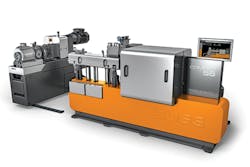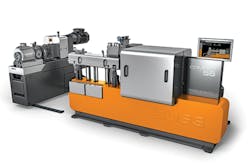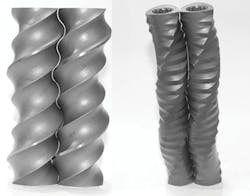Years of research culminated in the launch of new and upgraded equipment from compounding and extruder suppliers that showed their wares at NPE2018. They unveiled equipment for compounding, showcasing laboratory machines, new sizes and a time-saving process for producing colored resin, and touting features answering the call for Industry 4.0 capabilities and energy savings. Other benefits include increased flexibility, high outputs and improved mixing capabilities.
BUSS
Buss introduced its new Compeo compounder at NPE2018. The system, based on Buss' reciprocating kneader technology, will begin shipping next spring. The Compeo can cost-effectively compound a wide range of plastics, from temperature-sensitive PVCs and highly filled polyolefins to engineering polymers with processing temperatures of up to 750 degrees Fahrenheit, the company said. It comes in five sizes, with throughputs ranging from 88 pounds per hour to 15,430 pounds per hour, depending on material type.
Unlike former kneader models, Compeo compounders are fully configurable with interchangeable screw elements that allow for anywhere from two to six rows of screw flights. The configuration can be changed depending on the type of plastic being mixed. In addition, the process window is significantly larger, which allows the kneader screw to operate in a range of 100 revolutions per minute (rpm) to 600 rpm, with adjustments to maintain quality.
Because the machine is modular, users can change the length and configuration of the processing section, and the type and number of feeding units, as well as select from various temperature-control and degassing options. This flexibility allows operators to tailor the system to the processing task, the company said. As a result, processors who might otherwise have needed to buy different compounders now have the option of purchasing just one machine.
The Compeo discharge unit uses slowly rotating conical twin screws to produce adequate pressure to push the compounded material through a die plate, after which it is cut into pellets without a significant temperature increase. Other Buss compounders used a single-screw extruder or a gear pump.
"We went from a single-screw extruder to a conical screw pump," said Dave Pszczolkowski, VP and operations manager. "This allows us to use one standard design for all applications, whether it is a gentle PVC with a hot-face pelletizer or an engineering plastic that requires a higher-pressure die and interface or underwater pelletizer. The same equipment could generate higher or lower pressures without adding shear or any heat memory to the product."
The new screw geometries and improved raw material feeding units mean the compounder can achieve the throughputs of earlier models with 20 percent fewer screw rpm. In addition, Buss boosted torque by 15 percent to permit longer mixing zones without any additional increase in energy input.
A gearbox cover reduces noise and improves safety. Thermal insulation of the processing section minimizes energy losses, while a design based on standardized modules means that capital costs can be up to 30 percent less than those for previous models.
Compeo compounders come with a touch-screen controller with an OPC-UA interface that makes them Industry 4.0-compatible. A built-in recipe management feature means changing products can, in some cases, be as simple as pushing a button. All significant data points are displayed, logged and archived. In addition, process information such as temperatures, power consumption and system efficiency can be continuously monitored.
CPM CENTURY EXTRUSION
CPM Century Extrusion introduced its CXE 45 sHO extruder. The machine, with a screw outer diameter (OD) of 45mm, is a new size in the CXE line, filling a gap between existing machines with 26mm and 50mm screws.
"The CXE series is the highest level in our product line," said Charles Spearing, GM of global twin-screw operations for CPM Century Extrusion.
While the CXE series is about a decade old, the CXE 45 sHO has numerous new features, Spearing said.
"One, it is an 18-torque density, which is higher power per diameter and higher throughput," he said.
The "HO" in the name stands for high output, he said. The "s" stands for smart.
The CXE 45 sHO introduces new "smart" features that will be added to existing CXE series extruders in the future.
The smart features include:
• Technology that monitors the torque of each shaft, greatly reducing the risk of a machine failure due to imbalanced torque transmission.
• A system that measures oil quality with in-line analysis of temperature, moisture, light transmission and other characteristics.
• Energy monitoring that provides information about compounding efficiency through analysis of the electrical consumption by the motor, heaters and auxiliary equipment, as well as cooling-water consumption.
• Vibration sensors and temperature sensors for monitoring the processing section, selected bearings, gears, safety clutch and motor output and input shafts.
In addition, a new, efficient water-cooling system allows more precise temperature control and, in combination with a heavy-duty, high-power cartridge heater, the processing of high-temperature nylons for automotive applications, Spearing said.
CPM's high-performance screw elements allow for the gentle incorporation of glass fibers or thermosensitive flame retardants and additives. Also, high-performance screw elements on the CXE 45 sHO extruder can boost degassing efficiency because of higher surface regeneration.
"We have incorporated a lot of features on the machine to give the customer more process and performance data in real time," Spearing said.
Gearbox oil sensors constantly evaluate the oil for impurities, water content, contamination, air content and temperature. The extruder's control display shows the condition of the oil using green, yellow and red indicators. A green light means oil is within specifications; yellow means the oil is beginning to degrade; and red means it is substandard.
For each screw shaft, sensors assess and record the torque and provide information about shaft performance and the progression of wear on shafts and the barrel.
"We have a system where if we are nearing the yield stress of a shaft, it will shut the machine down as an extra protection of the machine," Spearing said.
This is the first time that monitoring technology has been available with a CPM twin-screw extruder, but it will be adopted on other CPM twin-screw extruders in the future, Spearing said.
Buyers have the option of purchasing a CXE 45 extruder without the smart features.
At NPE2018, CPM also demonstrated the RingExtruder RE 1 XPV, a co-rotating multi-screw extruder with 12 screw shafts for mixing and degassing operations. CPM is introducing the RingExtruder to several markets, including the U.S., following CPM's purchase last year of Extricom GmbH, which manufactures the Ring Extruder and has been renamed Extricom Extrusion.
It is designed to meet the needs of two main markets: recyclers processing PET flakes and rubber compounders.
Increased recycling of PET globally is fueling demand for the RingExtruder, according to the company.
The benefits of the 12-screw RingExtruder include: superior dispersive and distributive mixing, excellent degassing, improved temperature and residence control, reduced energy use and lower operating costs, the company said. With its 12 screw shafts, the extruder has an improved surface-to-volume ratio, making it an excellent choice for compounding temperature-sensitive materials.
STEER
Steer demonstrated its next-generation Omega Fractional Lobe Processor (FLP) screw, which is available only on Steer's Omega series of co-rotating twin-screw extruders.
"This is the third generation of our fractional [geometry] technology," said Robert Roden, associate VP of Steer America and global head of continuous manufacturing technology for Steer Engineering.
While previous versions of the company's fractional geometry technology comprised mixing elements used in a standard process section, the FLP screw technology is composed of 100 percent fractional elements.
"The intent is to use the entire process section for mixing and not to combine intensive mixing with simple conveying, which is typical of most processes today," Roden said. "FLP even uses mixing elements in the discharge section of the extruder to provide mixing and melt homogenization at high discharge pressures."
In June, Steer commissioned its first extruder with FLP technology. It provides devolatilization and mixing for a reactor product. Steer developed the technology a couple of years ago but has been testing it internally and only commercialized it within the past few months.
The focus of the FLP screw is to provide efficient mixing with lower energy consumption.
"We experience an average of 30 percent less energy consumption and up to 60 percent energy savings," Roden said. "This reduces melt temperatures and subsequent damage to polymers."
One outcome is that processors using an FLP screw will experience a significant improvement in intrinsic viscosity retention, Roden said.
In addition, the technology results in superior devolatilization performance, the company said.
"Our conveying elements provide a high degree of surface renewal and elongational mixing while conveying materials," Roden said. "The high degree of surface renewal, coupled with Steer's special vent designs, provides excellent devolatilization performance, enabling the removal of high volumes of volatiles."
In addition, the task-specific mixing elements provide the ideal type and intensity of mixing based on product requirements, Roden said. Elements of an FLP screw can be changed for specific applications with target outcomes, the company said.
In testing its new FLP screw, Steer reported excellent results in numerous applications, including devolatilization; the manufacture of additive masterbatch, color masterbatch, special-effects pigment masterbatch and foaming agent masterbatch; fiber retention in reinforced plastics; and reactive extrusion.
With its latest fractional geometry technology, Steer has solved problems associated with increases in melt temperature when kneading elements operate at high speeds by designing screw elements with unequal tip angles. Standard twin-screw elements have equal tip angles for all lobes.
Also, standard eccentric tri-lobed kneading elements have small tip angles, a fact that leads to a higher wear rate. However, Steer has developed elements with different tip angles, which can reduce the wear rate. Increasing the tip angle gives a circular shape to the element and reduces the free volume available in the extruder.
Using Steer's fractional geometry technology, rather than standard elements, it is possible to better control the compounding process, the company said. Steer's technology minimizes shear peaks but retains the self-wiping characteristics of twin screws.
In addition to ensuring shear uniformity, use of Steer's FLP screw achieves melt temperature reduction, extensional flow and fiber-length retention, making the technology ideal for sensitive polymers, the company said.
JAPAN STEEL WORKS
During NPE2018, Japan Steel Works (JSW) provided information about its newest twin-screw extruder, the TEX34aIII.
Although the TEX34aIII was not on display in Orlando, JSW showed a smaller TEX25aIII laboratory extruder, which is similar in design, but with a 26.5mm co-rotating twin screw instead of TEX34aIII's 36mm screw.
The TEX34aIII is designed for applications including compounding, chemical reaction, dewatering and devolatilizing.
It's a small extruder for small-lot production lines. The extruder's high torque density (18.2 newton meters per cubic centimeter) allows for effective but gentle compounding at low torque speeds, which keeps processing temperatures low without reducing throughput. If torque rises to an unacceptably high level, a torque-limiting function protects the machine by disengaging the drive motor and gearbox, stopping the screw.
Throughput typically reaches up to 1,100 pounds per hour with talc-filled PP, 551 pounds per hour in masterbatch compounding and 330 pounds per hour with polymer blends such asPC/ABS.
The new model also has an improved barrel design that allows for quick and easy barrel exchanges.
It comes in two models appropriate for different applications.
The standard model can be customized by adding multiple vents, adjusting the L:D ratio, and increasing the screw speed. Three motors are available for the standard model; they have capacities of 37, 55 or 75 kilowatts (kW).
A second model, with a control cabinet built into its frame, has been designed to take up less space and simplify installation. It comes with a 37-kW motor. It is approximately 14 feet long and 4 feet wide and weighs a little over 3.8 tons.
KRAUSSMAFFEI BERSTORFF
KraussMaffei Berstorff demonstrated how its ZE 28 BluePower twin-screw laboratory extruder can be used in a unique liquid-color compounding process to produce colored resins.
The demonstration produced colored PE, but the technology can be used with other resins, as well.
Colored compounds usually are based on mono-concentrates, which are produced in single-screw extruders in a separate process and stored, then fed into the twin-screw extruder in a second step. However, the new liquid-color compounding process unveiled at NPE2018 eliminates the first step and is simpler, faster, cost-effective and more accurate, the company said.
"You can make a number of different colors, one after the other," said Matt Sieverding, president of extrusion technology, KraussMaffei Berstorff. "It takes only 30 seconds to change a color over."
KraussMaffei Berstorff and Audia Liqui-Kolor, which sells liquid color products for the plastics industry, worked together for months prior to the show to develop the technology.
"What we did here is, you have six base colors: black, white and four other colors," Sieverding said. "You can make hundreds of different colors out of these colors. It is like an inkjet printer. That is the whole idea behind it."
The other four colors at the show were cyan, magenta, yellow and orange. However, the base colors can be tailored to a customer's specific needs.
KraussMaffei Berstorff can load color recipes in the extruder's proprietary process control system so users can blend colors at the touch of a button.
"If you want to change the color — we preloaded 12, but we could have loaded much more — you hit a button, and, boom, 30 seconds later, purple comes out," Sieverding said. "A lot of people are interested in it. It's very easy."
The setup wasn't the first time KraussMaffei Berstorff has shown off the technology, Sieverding said.
"We showed it the first time, our prototype, at our open house in October in Florence, Kentucky," he said. "This, now, is the commercialized version we are showing at NPE."
The ZE 28 BluePower extruder used in the NPE2018 demonstration was equipped with a system for metering liquids and solids so that custom colors could be produced on demand with any resin.
Because the ZE 28 twin-screw extruder is self-cleaning, changes from dark to light colors can be made flawlessly, the company said.
The compounding line exhibited at NPE2018 was equipped with an underwater pelletizer. The Liqui-Kreate liquid color metering system is available from Audia Liqui-Kolor.
ENTEK
Entek announced the rebranding of its larger, high-output twin-screw extruders.
Entek's 53mm, 73mm, 103mm and 133mm machines are now branded as the HR3 series, with the HR standing for high rate, high reliability and high return. The large-diameter-screw extruders are ideal for high-output compounding applications and production of masterbatch, sheet and profiles, the company said.
"We've put a lot of research and development into our QC3 line of smaller twin-screw extruders the past few years, and that continues," said Linda Campbell, Entek's director of sales. "But we didn't want to lose sight of the fact that our larger machines are a major source of our business and a great option for high-output compounding."
Entek displayed an HR3 73mm twin-screw extruder at NPE2018. It is available with a 600-horsepower motor and screw speeds of up to 900 rpm.
Bruce Geiselman, senior staff reporter
Contact:
Audia Liqui-Kolor, Holland, Mich., 616-394-3800, http://audialiquikolor.com
Buss Inc. USA,
Carol Stream, Ill., 630-933-9100,www.busscorp.com
CPM Century Extrusion,
Traverse City, Mich., 231-947-6400,www.cpmextrusiongroup.com
Entek Extruders, Lebanon, Ore., 541-259-1068, www.entek.com
Japan Steel Works America Inc.,
Farmington Hills, Mich., 248-536-0288,www.jswamerica.com
Krauss-Maffei Corp., Florence, Ky., 859-283-0200, www.kraussmaffeigroup.com
Steer America,
Uniontown, Ohio, 866-984-1800,www.steerworld.com
About the Author
Bruce Geiselman
Senior Staff Reporter Bruce Geiselman covers extrusion, blow molding, additive manufacturing, automation and end markets including automotive and packaging. He also writes features, including In Other Words and Problem Solved, for Plastics Machinery & Manufacturing, Plastics Recycling and The Journal of Blow Molding. He has extensive experience in daily and magazine journalism.




